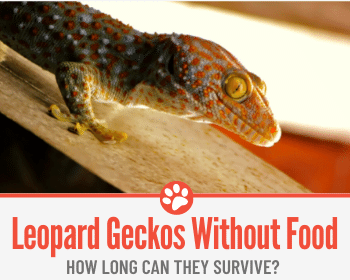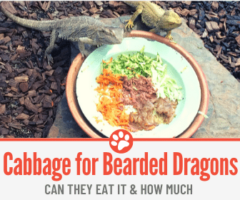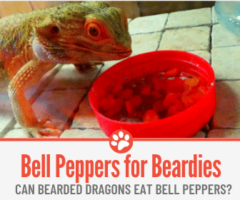 Are you becoming worried because of a few missed meals and you’re wondering how long can your leopard gecko go without eating?
Are you becoming worried because of a few missed meals and you’re wondering how long can your leopard gecko go without eating?
Leopard geckos have an unique ability to store fat in their tails.
This allows them to live greater periods of time without eating.
How Long Can Leopard Geckos Go Without Food?
It’s quite normal for leopard geckos to go weeks, sometimes even months during the colder months or in the mating season without eating!
A healthy tail should measure almost as wide as the rest of the body. If the tail becomes thin and “stick-like”, then that’s a good clue your pet isn’t eating properly. Rather than focusing on the number of meals missed, it’s important to become aware of some of the reasons why your reptile may have stopped eating to get your leopard gecko back on track quickly.
Obvious indicators of distress may be caused by extreme temperatures, unpleasant environment conditions, stressors, nourishment, and your reptile’s age determines how often will your leopard gecko eat.
Here are a few basics which will help you in understanding how long can leopard geckos go without food.
Temperature
If you’re wondering if it’s normal for a leopard gecko not to eat every day, the short answer is yes! There’s a variety of reasons why your pet isn’t eating. One of the most common ones is being exposed to extreme temperatures.
Think of bears that hibernate in the winter without seeking nourishment. Leopard geckos in nature go through a similar process, only it’s called brumation. During the colder months, it’s not uncommon for leopard geckos to vegetate until warmer weather arrives. In their natural habitat, these resilient reptiles have been known not to eat anything for several months!
How does temperature controls digestion?
Leopard geckos need heat to aid in digestion , so vigorous food digestion requires an ample amount of heat. When the temperatures begins to drop and seasons change, so does the animal’s digestion process.
Ideally, the surface temperature of your leopard gecko should hover between 88-92 degrees Fahrenheit (F). Respectively, ambient temperature should range between 75-84 F. Once an optimal temperature is maintained, normal feeding should resume.
To keep the temperature consistent, an under-tank heating pad or heating tape works well. Leopard geckos thrive when only one side of the enclosure is heated. This is recommended because leaving a “cool” side provides your reptile with an area to self-regulate body temperature.
Although heat rocks seem like a great addition, these items should be avoided due to the risk of burns. Extreme hot temperatures result in physical stress, dehydration and possibly even death. On the other hand, cold temperatures below 70 degrees F will cause your reptile to become lethargic and inactive.
Environment
In addition to maintaining a favourable temperature, other environmental factors should be considered when addressing how long can leopard geckos go without food.
Let’s look at how the appropriate substrate and lighting options play a role in keeping your leopard gecko healthy and happy.
Leopard geckos thrive in terrariums with the proper substrate. Keep it simple: use safe materials and replicate a natural habitat as much as possible.
Remember that these little guys are best suited for replicas of burrows, rocky crevices and clever hiding places
When considering materials, keep in mind that some materials can cause your leopard gecko’s digestive tract to become impacted. Even though widely used, loose substrate such as bark, cypress mulch, coconut fiber, walnut shells and sand can cause serious issues. If your reptile’s digestive system becomes obstructed with substrate material, not only will your pet stop eating, but it can also be fatal.
Safe substrate materials for leopard geckos includes:
-
Ceramic tiles
-
Slate
-
Paper towels
-
Newspaper
-
Flat stones
-
Pea gravel
-
Artificial turf
-
Bare floor
Eco Earth coconut-fiber is highly recommended, ideally for laybox and moist-hide substrates. One caveat: being too generous with the coconut fiber can result in a rapid increase of the humidity level which can cause serious respiratory issues in your pet.
Now let’s discuss lighting. If you are wondering Why is my leopard gecko not eating during the day?
That’s an easier question to answer – leopard geckos prefer to eat in the stillness of the night. Ceramic heat emitters works best to provide ideal low-lightning.
Reptile specific bulbs are also a good option. Existing overhead lighting can also be used to supplement heating the terrarium. Using bright lights can cause unnecessary stress on your leopard gecko and be harmful to their eyes. Having the ideal conditions for your gecko could be the difference between life and death of your pet.
Stress
If owning a leopard gecko for the first time, one of the first questions you’re going to want to know is: how often do leopard geckos eat? It’s a must that you allow some time for your new pet to adjust to its’ new surroundings.
When rehoming, it’s common for leopard geckos not to eat for a week or two due to stress. Introducing your leopard gecko to a new environment can be a very stressful transition. Even though you’re eager to welcome your reptile into the family, remaining low-key and avoiding handling as much as possible during the first couple of weeks greatly reduces stress.
Another way to reduce stress is by placing blinders on the enclosure. Blinders give your pet a sense of security and helps establish territorial boundaries. Once your leopard gecko feels safe inside its’ new home, a regular feeding schedule can be expected.
When we’re discussing how to eliminate stressors for your pet, location of the enclosure is important to take into consideration. The ideal place is a quiet spot with limited natural lighting. Extreme lightning, loud noise levels, and frequent social interactions may cause your pet to feel threatened and not be able to focus on eating.
Nourishment
How long a leopard gecko can go without eating often depends on what’s available on the menu. They thrive on a consistent diet of munchies including mealworms ,superworms, crickets and Dubia roaches. Remember to always provide your reptile with easy access to water.
For your pet to stay healthy, providing nourishment rich in vitamins and nutrients is a must! A common practice is known as “gut loading.” This is when feeder insects either ingest vitamin supplements or are dusted in a nutrient-rich powder prior to feeding.
If you’re opting for the first technique, you’ll need to give the feeder insects a powdered nutrient-rich diet 12 hours before mealtime. Once the gut-loaded appetizer is prepared, you’re ready to serve it. Slices of juicy potatoes work very well as a serving tray.
Another method is to sprinkle insects with a nutrient-rich dust before feeding. Simply combine insects and mix together in a small plastic bag, shake gently, and serve! A word of caution: try to avoid any extra dust getting into your leopard gecko’s eyes when serving the nutrient-covered gut-loaded treats.
A quick and easy solution to make the powder stick is to first apply a chick or other type of mash on the insects.
Another mess-free way to give your pet the vitamins and minerals needed to promote good health is by simply placing a small container filled with nutrient powder in the enclosure. There’s no need to worry about it ingesting too much powder because instinct will kick in when enough has been consumed.
While it’s exciting to watch your pet devour insects, your leopard gecko would appreciate privacy to dine alone. Any outside activity has the potential to cause stress, or distract from eating a full meal.
Take note. If your leopard gecko seems to be strategically avoiding superworms or crickets, it’s possible that it’s been bitten by a feeder insect.
Try using a replacement feeder such as mealworms, silkworms, hornworms, butterworms and Phoenix worms.
In addition to yummy delicacies, it’s very important to understand how long leopard geckos can go without water. Although it’s possible for mature reptiles to survive for up to 2 weeks, fresh water should be provided every 1 to 3 days.
Not only for consumption, but water’s essential for maintaining humidity and providing relief from shedding by soaking in a flat, non-spill water bowl.
Age
The age and gender of your pet can also help answer how long can leopard geckos go without food.
Mature leopard geckos, even as a pets, tend to go through an instinctual cooling down process. This period usually begins the first month of winter and may last for 2 to 3 months. During this period your leopard gecko may appear lethargic and refuse food. This is normal behaviour and should be expected to last for several months.
How often do leopard geckos eat when we’re talking about a mature ovulating female?
Typically, she will only eat about every 2 weeks during this time. Signs to look for include an obvious loss of appetite, visible follicles/ova under her belly, diminishing tail, and a puffy belly.
Due to the physiological changes and hormones fluctuating during this period, expect a loss of appetite that may span 1 to 3 months. After she has deposited her eggs, have her favourites and supplements on hand because she will have worked up a healthy appetite.
Related Questions
How long can leopard geckos go without water?
As a general rule of thumb, leopard geckos should be provided fresh water every 2 to3 days. In extreme situations, leopard geckos can go up to 2 weeks without water, however, it’s not recommended as dehydration and death are very possible outcomes. Water plays a vital role in maintaining humidity in the pet’s enclosure. Shedding reptiles also appreciate a nice soak in water bowls on occasion.
How often do leopard geckos eat mealworms?
Large mealworms make an ideal first meal given 2 to 3 days after being rehomed. A rule of thumb: feed 2 suitably sized mealworms for each inch of your reptile’s total body length. So, for a 2-inch-long leopard gecko offer 6 mealworms 3 to 4 times a weekly.






